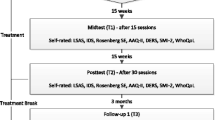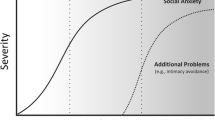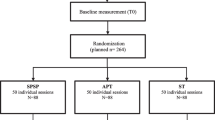Abstract
Avoidant personality disorder (AvPD) is a common and heterogeneous disorder. In spite of this, few studies have focused on treatment, and treatment guidelines have not been developed. In Scandinavian countries many patients with low levels of AvPD are treated sufficiently in private practices or in briefer psychiatric treatments, often for anxiety or depression. However, patients with higher levels of personality dysfunction are often not helped sufficiently by such treatments. In this paper we describe a longer and more intense treatment for severe AvPD based on a combination of Mentalization-Based Group Psychotherapy and Metacognitive Interpersonal Individual Therapy. This treatment has been piloted in Norway and Denmark, and we provide a case example of a successful treatment of a patient, “Julie” treated at Stolpegaard Psychotherapy Centre in Denmark. Based on our review of the literature and experiences from the pilot studies, we also provide some observations and general guidelines about important aspects of treatment of severe AvPD.
Similar content being viewed by others
References
Alden, L. (1989). Short-term structured treatment for avoidant personality disorder. Journal of Consulting and Clinical Psychology, 57(6), 756.
Alden, L., & Cappe, R. (1986). Interpersonal process training for shy clients. In W. H. Jones, J. M. Cheek, & S. R. Briggs (Eds.), Shyness (pp. 343–355). Boston: Springer.
Alden, L. E., & Capreol, M. J. (1993). Avoidant personality disorder: Interpersonal problems as predictors of treatment response. Behavior Therapy, 24(3), 357–376.
Alden, L. E., Wiggins, J. S., & Pincus, A. L. (1990). Construction of circumplex scales for the Inventory of Interpersonal Problems. Journal of Personality Assessment, 55(3–4), 521–536.
Arntz, A., Dreessen, L., Schouten, E., & Weertman, A. (2004). Beliefs in personality disorders: A test with the Personality Disorder Belief Questionnaire. Behaviour Research and Therapy, 42(10), 1215–1225.
Bagby, R. M., Parker, J. D. A., & Taylor, G. J. (1994). The twenty-item Toronto Alexithymia Scale—I. Item selection and cross-validation of the factor structure. Journal of Psychosomatic Research, 38(1), 23–32.
Bamelis, L. L., Evers, S. M., Spinhoven, P., & Arntz, A. (2014). Results of a multicenter randomized controlled trial of the clinical effectiveness of schema therapy for personality disorders. American Journal of Psychiatry, 171(3), 305–322.
Barber, J. P., Morse, J. Q., Krakauer, I. D., Chittams, J., & Crits-Christoph, K. (1997). Change in obsessive-compulsive and avoidant personality disorders following time-limited supportive-expressive therapy. Psychotherapy: Theory, Research, Practice, Training, 34(2), 133.
Bartak, A., Spreeuwenberg, M. D., Andrea, H., Holleman, L., Rijnierse, P., Rossum, B. V., & Emmelkamp, P. M. (2010). Effectiveness of different modalities of psychotherapeutic treatment for patients with cluster C personality disorders: Results of a large prospective multicentre study. Psychotherapy and Psychosomatics, 79(1), 20–30.
Bateman, A., & Fonagy, P. (2006). Mentalization-based treatment of borderline personality disorder: A practical guide. New York: Oxford University Press.
Bateman, A., & Fonagy, P. (2016). Mentalization-based treatment for personality disorders: a practical guide. New York: Oxford University Press.
Beck, A. T., Epstein, N., Brown, G., & Steer, R. A. (1988). An inventory for measuring clinical anxiety: Psychometric properties. Journal of Consulting and Clinical Psychology, 56(6), 893.
Beck, A. T., Ward, C. H., Mendelson, M., Mock, J., & Erbaugh, J. (1961). An inventory for measuring depression. Archives of General Psychiatry, 4(6), 561–571.
Beidel, D. C., Turner, S. M., Stanley, M. A., & Dancu, C. V. (1989). The Social Phobia and Anxiety Inventory: Concurrent and external validity. Behavior Therapy, 20(3), 417–427.
Bender, D. S. (2005). The therapeutic alliance in the treatment of personality disorders. Journal of Psychiatric Practice®, 11(2), 73–87.
Chan, C. C., Bach, P. A., & Bedwell, J. S. (2015). An integrative approach using third-generation cognitive-behavioral therapies for avoidant personality disorder. Clinical Case Studies, 14(6), 466–481.
Chiesa, M., & Fonagy, P. (2007). Prediction of medium-term outcome in cluster B personality disorder following residential and outpatient psychosocial treatment. Psychotherapy and Psychosomatics, 76(6), 347–353.
Colle, L., Pellecchia, G., Moroni, F., Carcione, A., Nicolò, G., Semerari, A., & Procacci, M. (2017). Levels of social sharing and clinical implications for severe social withdrawal in patients with personality disorders. Frontiers in Psychiatry, 8, 263.
Cramer, V., Torgersen, S., & Kringlen, E. (2007). Socio-demographic conditions, subjective somatic health, Axis I disorders and personality disorders in the common population: The relationship to quality of life. Journal of Personality Disorders, 21(5), 552–567.
Derogatis, L. R. (1994). Symptom checklist 90-R: Administration, scoring and procedures manual. Minneapolis: National Computer Systems Inc.
Derogatis, L. R. (1996). SCL-90-R: Symptom Checklist-90-R: Administration, scoring, and procedures manual. Minnesota: NCS Pearson.
Dimaggio, G., D’Urzo, M., Pasinetti, M., Salvatore, G., Lysaker, P. H., Catania, D., & Popolo, R. (2015a). Metacognitive interpersonal therapy for co-occurrent avoidant personality disorder and substance abuse. Journal of Clinical Psychology, 71(2), 157–166.
Dimaggio, G., Montano, A., Popolo, R., & Salvatore, G. (2015). Metacognitive interpersonal therapy for personality disorders: A treatment manual. New York: Routledge.
Dimaggio, G., Salvatore, G., MacBeth, A., Ottavi, P., Buonocore, L., & Popolo, R. (2017). Metacognitive interpersonal therapy for personality disorders: A case study series. Journal of Contemporary Psychotherapy, 47(1), 11–21.
Dimaggio, G., Semerari, A., Carcione, A., Nicolò, G., & Procacci, M. (2007). Psychotherapy of personality disorders: Metacognition, states of mind and interpersonal cycles. New York: Routledge.
Eikenaes, I., Gude, T., & Hoffart, A. (2006). Integrated wilderness therapy for avoidant personality disorder. Nordic Journal of Psychiatry, 60(4), 275–281.
Eikenaes, I., Hummelen, B., Abrahamsen, G., Andrea, H., & Wilberg, T. (2013). Personality functioning in patients with avoidant personality disorder and social phobia. Journal of Personality Disorders, 27(6), 746–763.
Emmelkamp, P. M., Benner, A., Kuipers, A., Feiertag, G. A., Koster, H. C., & van Apeldoorn, F. J. (2006). Comparison of brief dynamic and cognitive-behavioural therapies in avoidant personality disorder. The British Journal of Psychiatry, 189(1), 60–64.
EuroQol, G. (1990). EuroQol—A new facility for the measurement of health-related quality of life. Health Policy, 16(3), 199.
First, M. B., Spitzer, R. L., Gibbon, M., Williams, J., Davies, M., Bonis, J., et al. (1995). The Structured Clinical Interview for DSM-II-R Personality Disorders (SCID-II). Part II: Multi-site test-retest reliability study. Journal of personality disorders, 9(2), 92–104.
Fitts, W. H. (1965). Tennessee (Department of Mental Health) Self Concept Scale. Nashville: Counselor Recordings and Tests: Counselor Recordings and Tests.
Fraley, R. C., Waller, N. G., & Brennan, K. A. (2000). An item response theory analysis of self-report measures of adult attachment. Journal of personality and social psychology, 78(2), 350.
Gambrill, E. D., & Richey, C. A. (1975). An assertion inventory for use in assessment and research. Behavior Therapy, 6(4), 550–561.
Gilbert, S. E., & Gordon, K. C. (2013). Interpersonal psychotherapy informed treatment for avoidant personality disorder with subsequent depression. Clinical Case Studies, 12(2), 111–127.
Gordon-King, K., Schweitzer, R. D., & Dimaggio, G. (2018). Metacognitive interpersonal therapy for personality disorders featuring emotional inhibition: A multiple baseline case series. The Journal of Nervous and Mental Disease, 206(4), 263–269.
Gude, T., & Vaglum, P. (2001). One-year follow-up of patients with cluster C personality disorders: A prospective study comparing patients with “pure” and comorbid conditions within cluster C, and “pure” C with “pure” cluster A or B conditions. Journal of Personality Disorders, 15(3), 216–228.
Hamilton, M. A. X. (1959). The assessment of anxiety states by rating. British Journal of Medical Psychology, 32(1), 50–55.
Horowitz, L. M. (1988). Inventory of interpersonal problems: Psychometric properties and clinical Applications. Journal of Consulting and Clinical Psychology, 56(6), 885–892.
Huppert, J. D., Strunk, D. R., Ledley, D. R., Davidson, J. R., & Foa, E. B. (2008). Generalized social anxiety disorder and avoidant personality disorder: structural analysis and treatment outcome. Depress Anxiety, 25(5), 441–448.
Jackson, H. J., & Burgess, P. M. (2004). Personality disorders in the community: Results from the Australian National Survey of Mental Health and Well-being Part III. Relationships between specific type of personality disorder, Axis 1 mental disorders and physical conditions with disability and health consultations. Social Psychiatry and Psychiatric Epidemiology, 39(10), 765–776.
Jones, W. H., & Russell, D. (1982). The social reticence scale: An objective instrument to measure shyness. Journal of Personality Assessment, 46(6), 629–631.
Karterud, S. (2015). Mentalization-Based Group Therapy (MBT-G): A theoretical, clinical, and research manual. London: OUP Oxford.
Karterud, S., Pedersen, G., Bjordal, E., Brabrand, J., Friis, S., Haaseth, O., et al. (2003). Day treatment of patients with personality disorders: Experiences from a Norwegian treatment research network. Journal of Personality Disorders, 17(3), 243–262.
Klein, M. H., Benjamin, L. S., Rosenfeld, R., Treece, C., Husted, J., & Greist, J. H. (1993). The Wisconsin Personality Disorders Inventory: Development, reliability, and validity. Journal of Personality Disorders, 7(4), 285–303.
Krampen, G. (1991). Competence and control questionnaire. Göttingen: Hogrefe.
Krueger, R. F., Derringer, J., Markon, K. E., Watson, D., & Skodol, A. E. (2012). Initial construction of a maladaptive personality trait model and inventory for DSM-5. Psychological Medicine, 42(9), 1879–1890.
Kvarstein, E. H., Arnevik, E., Halsteinli, V., Ro, F. G., Karterud, S., & Wilberg, T. (2013). Health service costs and clinical gains of psychotherapy for personality disorders: A randomized controlled trial of day-hospital-based step-down treatment versus outpatient treatment at a specialist practice. BMC Psychiatry, 13, 315.
Kvarstein, E. H., & Karterud, S. (2013). Large variation of severity and longitudinal change of symptom distress among patients with personality disorders. Personal Mental Health, 7(4), 265–276.
Kvarstein, E. H., Nordviste, O., Dragland, L., & Wilberg, T. (2017). Outpatient psychodynamic group psychotherapy—Outcomes related to personality disorder, severity, age and gender. Personal Mental Health, 11(1), 37–50.
Lecrubier, Y., Sheehan, D. V., Weiller, E., Amorim, P., Bonora, I., Sheehan, K. H., et al. (1997). The Mini International Neuropsychiatric Interview (MINI). A short diagnostic structured interview: Reliability and validity according to the CIDI. European Psychiatry, 12, 224–231.
Lorentzen, S., Ruud, T., Fjeldstad, A., & Hoglend, P. A. (2015). Personality disorder moderates outcome in short- and long-term group analytic psychotherapy: A randomized clinical trial. British Journal of Clinical Psychology, 54(2), 129–146.
Millon, T., & Davis, R. (1997). National computer systems. In Millon Clinical Multiaxial Inventory-III Manual. Minneapolis: In: Inc.
Moroni, F., Procacci, M., Pellecchia, G., Semerari, A., Nicolo, G., Carcione, A. et al. (2016). Mindreading dysfunction in avoidant personality disorder compared with other personality disorders. Journal of Nervous and Mental Disease, 204(10), 752–757.
Muran, J. C., Segal, Z. V., Samstag, L. W., & Crawford, C. E. (1994). Patient pretreatment interpersonal problems and therapeutic alliance in short-term cognitive therapy. Journal of Consulting and Clinical Psychology, 62(1), 185.
Narud, K., Mykletun, A., & Dahl, A. A. (2005). A comparison of gains after treatment at a psychiatric outpatient clinic in patients with cluster A + B, or cluster C personality disorders, and non-psychotic axis I disorders. Nordic Journal of Psychiatry, 59(5), 331–338.
O’Brien, E. J. (1980). The self-report inventory: Development and validation of a multidimensional measure of the self-concept and sources of self-esteem.
Ogrodniczuk, J. S., Piper, W. E., & Joyce, A. S. (2011). Effect of alexithymia on the process and outcome of psychotherapy: A programmatic review. Psychiatry Research, 190(1), 43–48.
Popolo, R., MacBeth, A., Canfora, F., Rebecchi, D., Toselli, C., Salvatore, G., & Dimaggio, G. (2018). Metacognitive Interpersonal Therapy in group (MIT-G) for young adults with personality disorders: A pilot randomized controlled trial. Psychology and Psychotherapy: Theory, Research and Practice. https://doi.org/10.1111/papt.12182.
Pos, A. E. (2014). Emotion focused therapy for avoidant personality disorder: Pragmatic considerations for working with experientially avoidant clients. Journal of Contemporary Psychotherapy, 44(2), 127–139.
Renneberg, B. G., Alan, J., & Phillips, D. (1990). Intensive behavioral group treatment of avoidant personality disorder. Behavior Therapy, 21, 363–377.
Robinson, A. H., & Safer, D. L. (2012). Moderators of dialectical behavior therapy for binge eating disorder: Results from a randomized controlled trial. International Journal of Eating Disorders, 45(4), 597–602.
Seemüller, F., Meier, S., Obermeier, M., Musil, R., Bauer, M., Adli, M., et al. (2014). Three-Year long-term outcome of 458 naturalistically treated inpatients with major depressive episode: Severe relapse rates and risk factors. European Archives of Psychiatry and Clinical Neuroscience, 264(7), 567–575.
Simonsen, S., Heinskou, T., Sørensen, P., Folke, S., & Lau, M. (2017). Personality disorders: patient characteristics and level of outpatient treatment service. Nordic Journal of Psychiatry, 71(5), 325–331.
Skewes, S. A., Samson, R. A., Simpson, S. G., & van Vreeswijk, M. (2015). Short-term group schema therapy for mixed personality disorders: A pilot study. Frontiers in Psychology, 5(1592), 1592. https://doi.org/10.3389/fpsyg.2014.01592.
Skodol, A. E., Oldham, J. M., Bender, D. S., Dyck, I. R., Stout, R. L., Morey, L. C.,.. . Gunderson, J. G. (2005). Dimensional representations of DSM-IV personality disorders: Relationships to functional impairment. American Journal of Psychiatry, 162(10), 1919–1925.
Soeteman, D. I., Hakkaart-van, R. L., Verheul, R., & Busschbach, J. J. (2008). The economic burden of personality disorders in mental health care. J.Clin.Psychiatry, 69(2), 259–265.
Stevens, C. L., Muran, J. C., Safran, J. D., Gorman, B. S., & Arnold, W. (2007). Levels and patterns of the therapeutic alliance in brief psychotherapy. American Journal of Psychotherapy, 61(2), 109.
Stravynski, A., Belisle, M., Marcouiller, M., Lavallée, Y. J., & Eue, R. (1994). The treatment of avoidant personality disorder by social skills training in the clinic or in real-life settings. The Canadian Journal of Psychiatry, 39(8), 377–383.
Stravynski, A., Lesage, A., Marcouiller, M., & Elie, R. (1989). A test of the therapeutic mechanism in social skills training with avoidant personality disorder. The Journal of Nervous and Mental Disease, 177(12), 739–744.
Svartberg, M., Stiles, T., & Seltzer, M. (2004). Effectiveness of short-term dynamic psychotherapy and cognitive therapy for Cluster C personality disorders: A randomized controlled trial. American Journal of Psychiatry, 161, 810–817.
Thylstrup, B., Simonsen, S., Nemery, C., Simonsen, E., Noll, J. F., Myatt, M. W., & Hesse, M. (2016). Assessment of personality-related levels of functioning: A pilot study of clinical assessment of the DSM-5 level of personality functioning based on a semi-structured interview. BMC Psychiatry, 16, 298.
Torgersen, S., Kringlen, E., & Cramer, V. (2001). The prevalence of personality disorders in a community sample. Archives of General Psychiatry., 58(6), 590–596.
Tracey, T. J., & Kokotovic, A. M. (1989). Factor structure of the Working Alliance Inventory. Psychological Assessment: A Journal of Consulting and Clinical Psychology, 1(3), 207.
Tufekcioglu, S., Muran, J. C., Safran, J. D., & Winston, A. (2013). Personality disorder and early therapeutic alliance in two time-limited therapies. Psychotherapy Research, 23(6), 646–657.
Verheul, R., Andrea, H., Berghout, C. C., Dolan, C., Busschbach, J. J., van der Kroft, P. et al. (2008). Severity Indices of Personality Problems (SIPP-118): Development, factor structure, reliability, and validity. Psychological Assessment, 20(1), 23–34.
Verheul, R., Bartak, A., & Widiger, T. (2007). Prevalence and construct validity of personality not otherwise specified (PDNOS). Journal of Personality Disorders, 21(4), 359–370.
Vrabel, K. A. R., Hoffart, A., Ro, O., Martinsen, E. W., & Rosenvinge, J. H. (2010). Co-occurrence of avoidant personality disorder and child sexual abuse predicts poor outcome in long-standing eating disorder. Journal of Abnormal Psychology, 119(3), 623–629.
Watson, D., & Friend, R. (1969). Measurement of social-evaluative anxiety. Journal of Consulting and Clinical Psychology, 33(4), 448–457.
Weinbrecht, A., Schulze, L., Boettcher, J., & Renneberg, B. (2016). Avoidant personality disorder: A current review. Current Psychiatry Report, 18(3), 29.
Weissman, M. M., & Bothwell, S. (1976). Assessment of social adjustment by patient self-report. Archives of General Psychiatry, 33(9), 1111–1115.
Wilberg, T., Karterud, S., Pedersen, G., & Urnes, O. (2009). The impact of avoidant personality disorder on psychosocial impairment is substantial. Nordic Journal of Psychiatry, 63(5), 390–396.
Wilberg, T., Karterud, S., Pedersen, G., Urnes, O., Irion, T., Brabrand, J., et al. (2003). Outpatient group psychotherapy following day treatment for patients with personality disorders. Journal of Personality Disorders, 17(6), 510.
Zimmerman, M., Rothschild, L., & Chelminski, I. (2005). The prevalence of DSM-IV personality disorders in psychiatric outpatients. American Journal of Psychiatry, 162(10), 1911–1918.
Zimmermann, P., Alliger-Horn, C., Kowalski, J. T., Plate, S., Wallner, F., Wolff, E., & Strohle, A. (2013). Treatment of avoidant personality traits in a German Armed Forces inpatient psychiatric setting. Military Medicine, 178(2), 213–217.
Author information
Authors and Affiliations
Corresponding author
Ethics declarations
Conflict of interest
All authors declare that they have no conflict of interest.
Ethical Approval
All procedures performed in this study involving human participants were in accordance with the ethical standards of the institutional and/or national research committee and with the 1964 Helsinki declaration and its later amendments or comparable ethical standards. This article does not contain any studies with animals performed by any of the authors.
Informed Consent
Informed consent was obtained from the patient presented in this article.
Rights and permissions
About this article
Cite this article
Simonsen, S., Eikenæs, I.UM., Nørgaard, N.L. et al. Specialized Treatment for Patients with Severe Avoidant Personality Disorder: Experiences from Scandinavia. J Contemp Psychother 49, 27–38 (2019). https://doi.org/10.1007/s10879-018-9395-x
Published:
Issue Date:
DOI: https://doi.org/10.1007/s10879-018-9395-x




